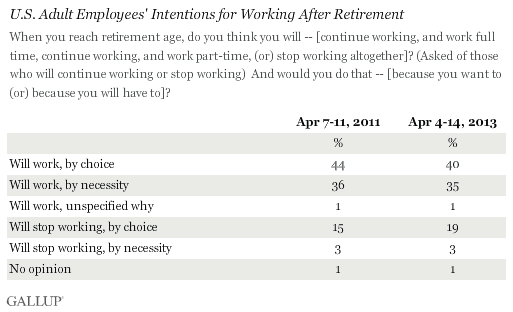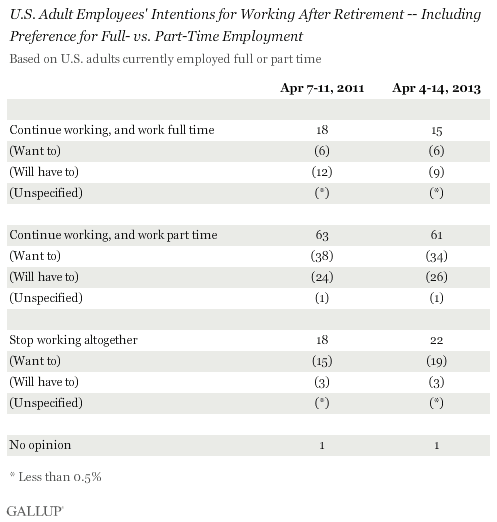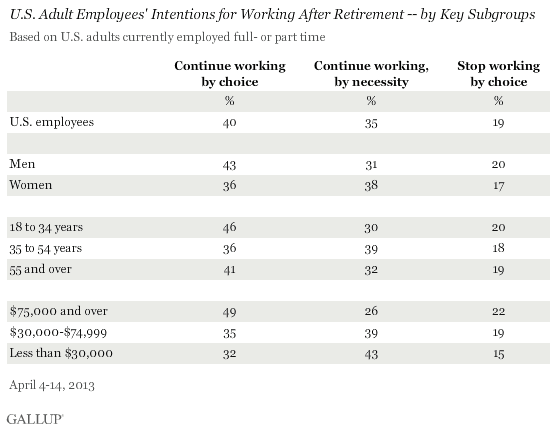PRINCETON, NJ -- Three-quarters of U.S. adult workers believe they will continue working past retirement age, with 40% saying they will do so because they want to, and 35% because they will have to. A much smaller percentage -- 19% -- fit the prototypical retirement scenario of someone who plans to stop working at retirement age by choice.

These preferences are essentially the same as they were two years ago, when Gallup first measured these employment intentions.
Half of Americans surveyed in the April 4-14 poll are employed, including 44% who work full time and 10% part time. That does not include people who identify their status as a student, homemaker, or retiree, but who may also be working. When thinking ahead to their retirement, however, most employed Americans -- 61% -- plan to work part time, while just 15% will work full time. The remaining 24% don't intend to work or aren't sure.
Notably, those who plan to work part time are more likely to do it because they want to (34% of all workers) than because they have to (26%), whereas those intending to work full time are more likely to say it is out of need (9%) rather than desire (6%).

Men and Americans under age 35 are slightly more likely than their counterparts to say they want to, rather than need to, continue working past retirement age. However, there are bigger differences by household income, with those earning $75,000 or more the most eager to remain in the workforce.
Overall, about three-quarters of upper-income Americans as well as those earning less than $75,000 annually intend to work past retirement. However, for those already earning a comfortable living, it is more of a choice than a necessity. That is evident in the finding that nearly half of those earning $75,000 or more say they plan to work past retirement because they want to. That compares with roughly a third of adults in lower income categories. Middle- and lower-income workers are significantly more likely than upper-income ones to say they will continue working because they have to.

This conforms with another finding in the same poll, in which middle-income and, to an even greater degree, lower-income Americans are more likely than upper-income Americans to say part-time work will be a major source of income for them in their retirement.
Bottom Line
"Retirement" once connoted a lifestyle free from the demands of work, but also reliance on personal savings and Social Security. Both of those impressions may change if Americans carry through on their intent to continue working, at least part time, after reaching retirement age. While this could be a disappointment to some retirees, it could have benefits both socially and health-wise for Americans, if staying in the workforce keeps seniors more physically and mentally active than they would be otherwise. It would clearly help them financially, particularly if the alternative is dependency on inadequate retirement savings and an uncertain Social Security system. This, in turn, could benefit the economy, with seniors contributing experienced labor as well as earning income that fuels consumer spending and, therefore, the economy as a whole.
Survey Methods
Results for this Gallup poll are based on telephone interviews conducted April 4-14, 2013, with a random sample of 1,005 adults, aged 18 and older, living in all 50 U.S. states and the District of Columbia.
For results based on the total sample of national adults, one can say with 95% confidence that the margin of sampling error is ±3 percentage points.
For results based on the sample of 1,005 nonretirees who work full or part time, the margin of sampling error is ±3 percentage points.
Interviews are conducted with respondents on landline telephones and cellular phones, with interviews conducted in Spanish for respondents who are primarily Spanish-speaking. Each sample of national adults includes a minimum quota of 50% cellphone respondents and 50% landline respondents, with additional minimum quotas by region. Landline telephone numbers are chosen at random among listed telephone numbers. Cellphone numbers are selected using random digit dial methods. Landline respondents are chosen at random within each household on the basis of which member had the most recent birthday.
Samples are weighted to correct for unequal selection probability, nonresponse, and double coverage of landline and cell users in the two sampling frames. They are also weighted to match the national demographics of gender, age, race, Hispanic ethnicity, education, region, population density, and phone status (cellphone only/landline only/both, cellphone mostly, and having an unlisted landline number). Demographic weighting targets are based on the March 2012 Current Population Survey figures for the aged 18 and older U.S. population. Phone status targets are based on the July-December 2011 National Health Interview Survey. Population density targets are based on the 2010 census. All reported margins of sampling error include the computed design effects for weighting.
In addition to sampling error, question wording and practical difficulties in conducting surveys can introduce error or bias into the findings of public opinion polls.
View methodology, full question results, and trend data.
For more details on Gallup's polling methodology, visit www.gallup.com.
